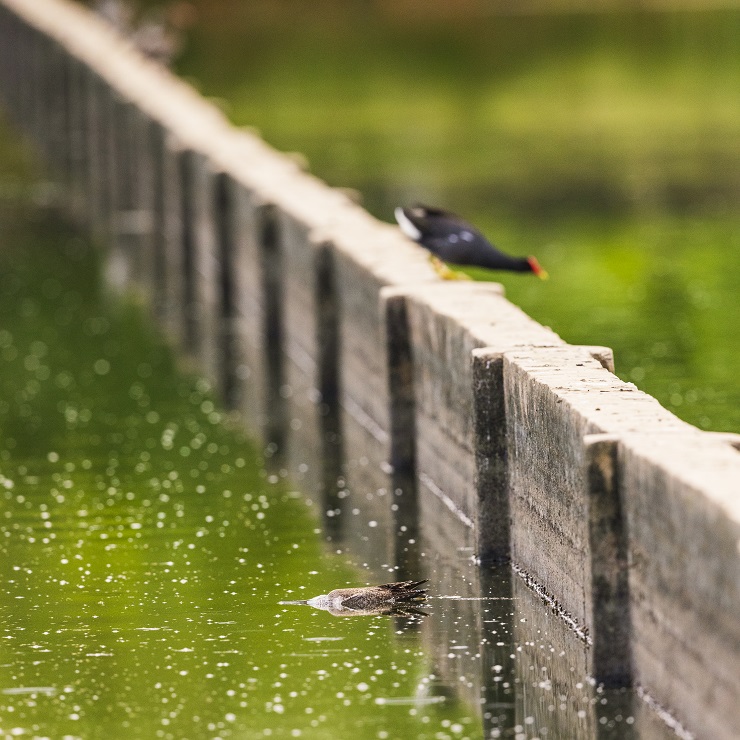
Yesterday morning was simply one of those incredibly eventful birding sessions, about which I may expound upon in parts within the coming weeks. After several (relatively) run-of-the-mill birding missions within the rainforest and along the coasts of Tobago over the last few weeks, we kept getting our socks knocked off while birding the wetlands of southwest Tobago yesterday. From genuine rarities to undocumented polymorphism – the magic of birding was truly in full swing. Rising above all within my psyche however, is the following sequence of events that unfolded before breakfast.
On a tiny island there is a limited selection of locations, and I have written about these ponds on a prior post. Upon arrival, activity seemed slow. Most of the birds were in the furthest ponds, a pair of juvenile Black Skimmers were practicing their technique within the confines of the rectangular ponds. A concrete wall halving one of the ponds was a popular rest spot for several birds. Interested in making photographs, I drifted away from this wall.

Take note of this Greater Yellowlegs on the wall from a screengrab of a video of the Black Skimmer.

My attention was pulled to the wall when I noticed this motley crew of shorebirds. L-R: White-rumped Sandpiper, Pectoral Sandpiper, Greater Yellowlegs, Short-billed Dowitcher, Greater Yellowlegs
To my surprise, quietly floating beside the wall was the limp body of a Greater Yellowlegs, some of its feathers still dry. Its head drifted awkwardly away from its lifeless body. Somehow within the quiet stillness of this cool tropical morning, a bird closed its eyes for the last time and unceremoniously slipped away under the brooding, overcast sky. Without so much as a splash, it slipped into the water.

A moment of silence for the departed.
I say unceremoniously – but I am using the human metric by which we decide what makes noise and what doesn’t. Clearly there was some measure of communication; some broadcast message went out to all relevant parties. Life departed from yet another little body, and all were notified.
Over the course of the following hour or so we observed many different species *coincidentally* alight on the wall near to the body of the fallen yellowlegs. Only species not pictured is Lesser Yellowlegs, when a pair flew in I was too busy comparing the size of the floating body to the live birds to properly ascertain the ID of the dead bird. Apologies for excluding them from this carousel.

This Common Gallinule walked from where it was perched to this point, made a couple strange positions with its body, then flew off.

This Black-bellied Whistling Duck was on its way to visit its mate and young brood further afield in the same pond but made a detour.

Spotted Sandpiper

We left this pair of Least Sandpipers on the scene.
There are many questions which follow an observation such as this. I spoke a few posts ago on the bond between a Whimbrel and a Willet (I can confirm we saw the same pair, still together, later this same morning) – and I noticed a similar kinship between a Pectoral Sandpiper and a White-rumped Sandpiper. Wherever one flew, so did the other. With similar migration routes, would this pair travel together from one corner of the planet to the other?

Pectoral Sandpiper (L) and White-rumped Sandpiper (R)
Further consideration must be given to the nature of the visitations. Paying respects? Was it some sort of funeral? Did the Black-bellied Whistling Duck represent his family, “showing face” as we say here in the Caribbean? Or was it all dumb luck, the randomness of nature at play, pure coincidence?
Animals obviously see death and experience it as we do, so the question is not one of if, but of how. Elephants, peccaries, and corvids have all been documented processing the death of (as we put it) a loved one. As far as I am aware, these practices have always involved a member of the family group, the flock – at the very least a member of the same species. This is not an attempt to anthropomorphize, as that would indicate that humans are the only creatures capable of possessing certain characteristics. There is much we still need to learn as a species occupying real estate on this planet (as if the ecological crisis didn’t already make that abundantly clear) but I believe the biggest hurdle may be coming to terms with accepting that just because something hasn’t been observed doesn’t indicate its non-existence.













A very nice post, Faraaz! ?
And a moment of silence for our lost companion…
…
This write up gave me goosebumps. Thank you for this astonishing observation.
Your writing reminds me somewhat and not in a poor way of Dickens
Thank you everyone for your kind words. I am only a witness!